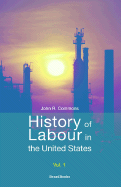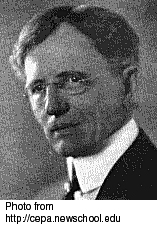
|
History of Labour in the United States
By John Rogers Commons
1998/12 - Beard Books - Business Classic
Volume I -649 pp.
1893122743 - Paperback - Reprint
US$34.95

|
Volume II - 640 pp.
1893122751 - Paperback - Reprint
US$34.95
 |
|

|
A fascinating look at the early historical labor movements in America as a
social and political force.
Publisher Comments
A series of articles by various authors designed to reveal the history of the labour movement in America as a social and political force. Rather than expounding on the history of labour organizations or the history of the technical application of labour to the process of production, this work traces the history of movements with their philosophies and ideals. The periods covered are: colonial and federal beginnings (to 1827); citizenship (1827 - 1833); trade unionism (1833 - 1839); humanitarianism (1840 - 1860); nationalisation (1860 - 1877); and upheaval and reorganisation (since 1876). These historical periods have produced not only characteristic movements but also characteristic arguments, theories and philosophies, designed to win converts to the movements or support from the public. This work will have great appeal to historians, economists, political scientists, as well as any fascinated by the rise of the labor movements and philosophies in this nation.

No book review available

 John Rogers Commons was born on Oct. 13, 1862 in Hollandsburg, Ohio. He was a well-known economist who became the foremost authority on U.S. labour in the first third of the 20th century. He studied at Oberlin College and at John Hopkins University and taught at the University of Wisconsin (1904-32). He established his reputation with the publication of A Documentary History of American Industrial Society, 10 vol. (1910-11), and History of Labour in the United States, 4 vol. (1918-35). Commons' theory of the evolution of the American labour movement in terms of changes in the market structure was generally accepted. After World War I, Commons broadened his reputation with the publication of Legal Foundations of Capitalism (1924) and its sequel, Institutional Economics (1934). Commons drafted much of the reform legislation that made Wisconsin an example for other states. He also made notable contributions to the federal government in the areas of civil service, public utilities, workmen's compensation, and unemployment insurance. John Rogers Commons was born on Oct. 13, 1862 in Hollandsburg, Ohio. He was a well-known economist who became the foremost authority on U.S. labour in the first third of the 20th century. He studied at Oberlin College and at John Hopkins University and taught at the University of Wisconsin (1904-32). He established his reputation with the publication of A Documentary History of American Industrial Society, 10 vol. (1910-11), and History of Labour in the United States, 4 vol. (1918-35). Commons' theory of the evolution of the American labour movement in terms of changes in the market structure was generally accepted. After World War I, Commons broadened his reputation with the publication of Legal Foundations of Capitalism (1924) and its sequel, Institutional Economics (1934). Commons drafted much of the reform legislation that made Wisconsin an example for other states. He also made notable contributions to the federal government in the areas of civil service, public utilities, workmen's compensation, and unemployment insurance.
He died on May 11, 1945 in Fort Lauderdale, Florida.

|
Introduction |
|
| Part I. |
Colonial and Federal Beginnings (To 1827) |
|
| Chapter I |
Origin of Trade Unions |
I, 25 |
| Chapter II |
Development of Bargaining Classes |
I, 32 |
| Chapter III |
The Merchant-Capitalist |
I, 88 |
| Chapter IV |
Early Trade Unions |
I, 108 |
| Chapter V |
Cordwainers' Conspiracy Cases, 1806-1815 |
I, 138 |
| Chapter VI |
Signs of Awakening, 1820-1827 |
I, 153 |
| Part II. |
Citizenship (1827-1833) |
|
| Chapter I |
Causes of the Awakening |
I, 169 |
| Chapter II |
Rise and Growth in Philadelphia |
I, 185 |
| Chapter III |
Workingmen's Parties in New York |
I, 231 |
| Chapter IV |
Speed of the Movement |
I, 285 |
| Chapter V |
New England Association of Farmers, Mechanics and Other
Workingmen |
I, 302 |
| Chapter VI |
Results of the Awakening |
I, 326 |
| Part III. |
Trade Unionism (1833-1839) |
|
| Chapter I |
The Turn to Trade Unionism |
I, 335 |
| Chapter II |
The City Trades' Union |
I, 357 |
| Chapter III |
Trade Unionism in Action |
I, 381 |
| Chapter IV |
The National Trades' Union |
I, 424 |
| Chapter V |
Premature National Trade Unions |
I, 439 |
| Chapter VI |
Disintegration |
I, 454 |
|
Appendices |
|
| I |
First Dates on Which Trade Societies Appeared in New York,
Baltimore, Philadelphia, and Boston, 1833-1837 |
I, 472 |
| II |
Strikes, 1833-1837 |
I, 478 |
| Part IV. |
Humanitarianism (1840-1860) |
|
| Chapter I |
Depression and Immigration |
I, 487 |
| Chapter II |
Association and Co-Operation |
I, 493 |
| Chapter III |
The New Agrarianism |
I, 522 |
| Chapter IV |
The Ten-Hour Movement |
I, 536 |
| Chapter V |
The Industrial Congresses |
I, 547 |
| Chapter VI |
Co-Operative Unionism |
I, 564 |
| Chapter VII |
The New Trade Unionism |
I, 575 |
| Part V. |
Nationalisation (1860-1877) |
|
| Chapter I |
Economic Conditions |
II, 3 |
| Chapter II |
The War Period, 1861-1865 |
II, 13 |
| Chapter III |
The National Trade Unions, 1864-1873 |
II, 42 |
| Chapter IV |
The National Labor Union, 1866-1872 |
II, 85 |
| Chapter V |
Disintegration, 1873-1877 |
II, 156 |
| Part VI. |
Upheaval and Reorganisation (Since 1876) |
|
| Chapter I |
Secret Beginnings |
II, 195 |
| Chapter II |
Revolutionary Beginnings |
II, 203 |
| Chapter III |
Attempted Union -- the Pittsburgh Convention of 1876 |
II, 235 |
| Chapter IV |
The Greenback Labor Agitation, 1876-1880 |
II, 240 |
| Chapter V |
The Anti-Chinese Agitation in California |
II, 252 |
| Chapter VI |
From Socialism to Anarchism and Syndicalism, 1876-1884 |
II, 269 |
| Chapter VII |
The New Trade Unionism, 1878-1884 |
II, 301 |
| Chapter VIII |
End of Secrecy in the Knights and Deviation From First
Principles, 1876-1884 |
II, 332 |
| Chapter IX |
The Great Upheaval, 1884-1886 |
II, 356 |
| Chapter X |
The Aftermath, 1886-1887 |
II, 395 |
| Chapter XI |
The Failure of Co-Operation, 1884-1887 |
II, 430 |
| Chapter XII |
The Political Upheaval, 1886-1887 |
II, 439 |
| Chapter XIII |
Reorganisation, 1888-1896 |
II, 471 |
| Chapter XIV |
Recent Developments (From 1896) |
II, 521 |
|
Bibliography |
|
|
Bibliography |
II, 541 |
|
